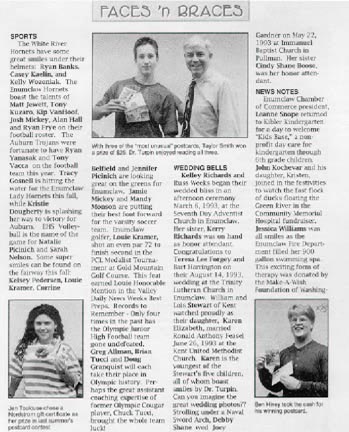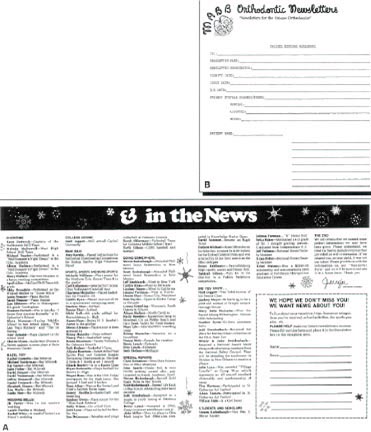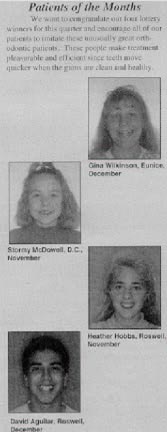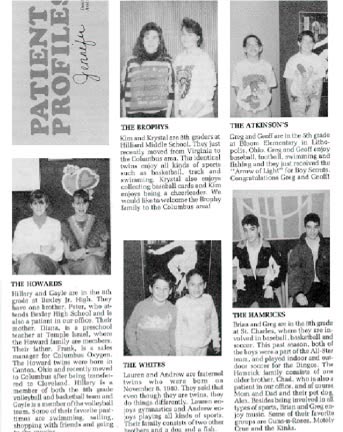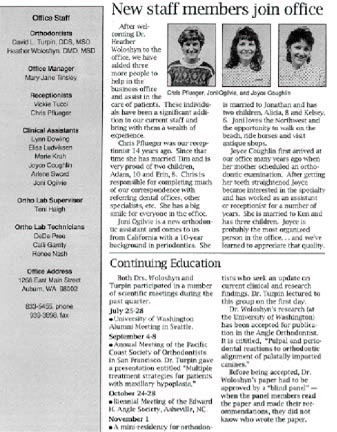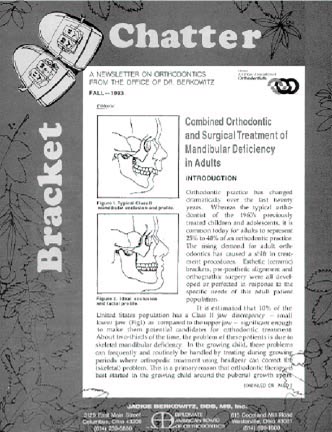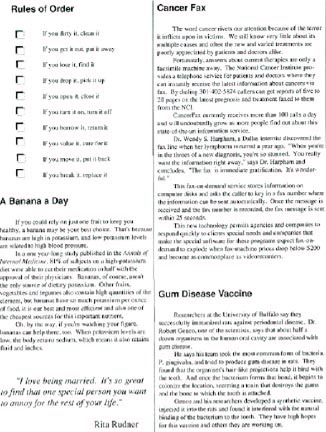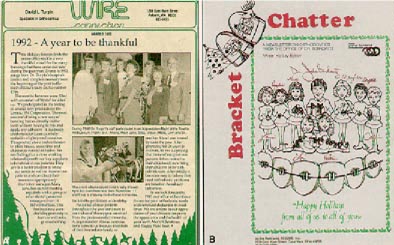Publish Your Own Practice Newsletter
Only about 17% of U.S. orthodontists distribute a practice newsletter, and those who do rate it only fair, on average, as a practice-building method.1 Still, for a substantial number of orthodontists, the newsletter is an effective way to communicate with patients, parents, and referral sources and to publicize the work of the practice in the community.
The AAO and several companies sell preprinted newsletters that can be imprinted with your own name and address, for distribution to patients and parents or to referring dentists. However, any practice that chooses to devote the time and effort required to produce its own newsletter should be able to do so with a minimal investment in equipment and software.
Once you decide you would like to publish your own newsletter, there are several other decisions you need to make:
1. How often will you publish--annually, semiannually, quarterly, monthly?
2. Who will be the editor--the orthodontist, a staff member, an outside consultant?
3. What kinds of material are you going to include--general health, dental health, technology, general information, news about the practice, news about patients and their families, humor, puzzles?
4. Where will the material come from--the staff, patients and their families, reference sources, outside services?
5. What kinds of graphics would you like to use--"clip art", other line drawings, charts and graphs, halftones (black-and-white photographs), color drawings, full-color illustrations?
6. How will the design and production be handled--in the office (manually or using a computer page-design program) or by an outside designer?
7. What level of quality do you want in typesetting, paper, printing?
8. To whom will you distribute your newsletter--active patients and their families, inactive patients, prospective patients, referrers, referral prospects, friends, colleagues?
All of these decisions will affect the overall quality of your newsletter, its cost, and its effectiveness. There is no single correct method, but the experience of colleagues can be a guide. Three orthodontists who currently produce outstanding practice newsletters--Dr. Jackie Berkowitz of Columbus, Ohio, Dr. David L. Turpin of Auburn, Washington, and Dr. Larry White of Hobbs, New Mexico--were asked to describe their operations for this article.
Editorial
All three orthodontists publish their newsletters about once per quarter, although Dr. Berkowitz said he times his issues at varying intervals around events such as holidays, the start of the school year, sports seasons, a new associate, or new office equipment. Editorial responsibility ranges from the orthodontist (Dr. White) to a hygienist acting as internal newsletter coordinator (Dr. Berkowitz) to the entire staff (Dr. Turpin).
All include a wide variety of subject matter, from general interest to dental health, but focus primarily on news about the practice and patients. It is a truism that people like to see their names in the paper, and this seems to be the key advantage of individual practice newsletters over mass-produced editions.
"A major portion of our newsletter is comprised of the 'Faces 'n Braces' column," Dr. Turpin said (Fig. 1). "This news section includes the names of nearly 100 past and present patients who, for one reason or another, deserve attention. Everyone in the office is challenged to find out what our patients are doing at home, school, or work that is special. This bit of information is written down on a piece of note paper and saved until we're ready to write the column. It is the most widely read section of the newsletter."
"We attempt to include the names of as many patients and staff as possible," said Dr. Berkowitz (Fig. 2). "In addition, we highlight those patients who are not necessarily sports superstars, but do something as simple as visit their grandparents over a holiday weekend. Our chairside auxiliaries will question patients and get them to fill out an information form about themselves. We search newspapers citywide and locally and generally keep our ears open for information."
Dr. White publishes pictures of his "Patients of the Month" in each issue (Fig. 3), and Dr. Berkowitz does "Patient Profiles" (Fig. 4). Dr. Turpin includes occasional feature stories about patients. Staff news, particularly in the area of continuing education, is another constant theme (Fig. 5).
All three newsletters usually feature some kind of lead story on the front page. Dr. Berkowitz likes to use his lead editorial to highlight some aspect of the relationship between general dentistry and orthodontics, as a way to interest his referrers (Fig. 6).
The three practices are continuously gathering material, especially news about patients and staff. Dr. Turpin said his feature articles are usually prepared about a month before each publication deadline. Dr. White, who uses the most general-interest material in his newsletter (Fig. 7), said, "The sources are the various and sundry periodicals I receive, plus professional periodicals. I collect the material and file it, then select the items I want to use for each issue."
Black-and-white photographs (halftones) of patients and staff are printed in all three newsletters. Dr. Turpin said, "Most photographs are taken in our office over a two-week period before publication. We use black-and-white film (400 ASA) with no flash. These are custom-printed to achieve the quality needed for publication." All three also use computer graphics--either "clip art" or custom-made illustrations--and some line drawings.
Drs. Turpin and White prepare their articles with their office computer word-processing programs. Dr. Berkowitz has his typed in the office and then sent to an outside typesetter, who handles all the production in liaison with the office newsletter coordinator.
Production
Desktop publishing now allows individual orthodontists to produce newsletters that look as polished as commercial editions. Drs. Turpin and White use PageMaker software for designing their pages. Dr. White has his own Macintosh system, while Dr. Turpin turns his material over to an outside contractor, who does the layout on a Windows system and prepares each edition for the printer. Other popular and powerful publishing programs include Quark XPress and Ventura Publisher.
There is a strong temptation when using today's computer technology--scanners, photo CDs, paintbrush and illustrator programs, and desktop publishing software--to squeeze as many bells and whistles as possible into each page. Keep in mind that the goal of the newsletter is to communicate, and that a page with dozens of type styles and fonts and multiple background overlays is difficult to read.
A perfectly good newsletter, including graphics, can be produced with any common word-processing software, such as WordPerfect. Stick to one type family for the text and a complementary or contrasting font for the headlines and captions. Graphics can be attractive, but they must contribute to rather than detract from the readability of the newsletter.
Dr. Turpin uses a second ink color in addition to black, and Dr. Berkowitz uses two additional colors (Fig. 8). Color adds interest and emphasis as long as it does not obscure the text.
Drs. Turpin and White use a heavy uncoated paper, while Dr. Berkowitz uses glossy stock. Drs. Berkowitz and White print their newsletters on white paper, Dr. Turpin on ivory. There are no hard and fast rules governing the use of color and paper stock, except that dark ink on light paper is easier to read than the reverse. Like the front page and title (flag) of the newsletter, however, the paper should be consistent from one issue to the next to promote recognition.
All three of the orthodontists surveyed for this article use outside typesetters and offset printing for high production quality. A newsletter could be printed out on the office laser printer and then photocopied, but the reproduction of photographs might not be acceptable.
Distribution
If the newsletter is to be an effective marketing tool, the distribution should be as wide as is reasonably possible. The cost of printing and mailing 3,000 newsletters, for example, is not significantly greater than that of 2,000 newsletters.
Active patients and their families are obvious recipients; Dr. White includes "all of the families who have ever been in the practice", and Dr. Turpin mails to "all patients of record, even those who have been in retention for as long as five years". Drs. Berkowitz and White also keep dental colleagues and referral sources on their mailing lists. In fact, Dr. White mentioned that he is happy to add any orthodontist to his mailing list on request.
If a practice has its patient records on computer, then the computer can easily generate mailing labels for the newsletter. Word-processing or data-base programs can also handle this task once all the names and addresses are entered.
Drs. Turpin and White, each of whom distribute about 3,000 copies per issue, have their newsletters sent by an outside mailing house under a bulk mailing permit. Dr. Berkowitz distributes most of his 1,200 copies at regular appointments in the office and sends the rest by first-class mail.
The total cost per issue, including production, printing, and mailing, is about $1,250 for Dr. Berkowitz, $2,600 for Dr. Turpin, and $1,500 for Dr. White. Of course, the number of copies, the number of pages per issue, the use of color and halftones, the type of paper, and the class of mail all factor into the cost equation.
Conclusion
None of the three orthodontists could say whether his newsletter had paid for itself in terms of referrals. I suspect that a newsletter must first of all be a labor of love for the practice, and particularly for the person or persons who put it together. Two of the practitioners I surveyed are also well-known dental editors--Dr. Turpin with The Angle Orthodontist and Dr. White with JCO.
"I've read many of the various types of newsletters produced throughout the United States," said Dr. White, "and the biggest defect I've noticed is the lack of personal involvement by the doctor. Too many of the publications look 'canned' and have too little useful information in them. Doctors should expect a learning curve both in assembling the publication and in mastering the desktop publishing skills necessary to make it efficient, useful, and attractive. If they don't want to do it, they must be willing to find and pay competent people to do it for them."
Dr. Turpin felt a newsletter could be beneficial to a practice in three major areas: communication, staff effectiveness, and public relations. "It provides a mechanism for communicating your views on a number of issues related to orthodontics and health care in general. Staff effectiveness is increased by involving the whole office in the gathering of news items. There isn't one child in your office who isn't very special in some way; the challenge is to find what it is. By helping to write the newsletter, staff members are forced to think more carefully about office policies. The newsletter is also a way to publicize office participation in community and charitable activities. Your public relations are enhanced simply by reminding all active and retention patients that your office is there to help in any way possible."
"It is a way to acknowledge the confidence that patients and families have had in us in the past and to let them know we are still interested in them and are available should they need us," said Dr. White. "I'm not sure you could ever accurately measure the effect of these messages, but we continue to receive much favorable comment about the newsletter."
Dr. Berkowitz said, "I believe the newsletter fits nicely into our practice philosophy of excellent communication. It provides us with the opportunity to personalize our practice for our patients, and we include articles on various areas of orthodontic therapy to support our clinical instructions. The success of an office newsletter is based on being able to develop the internal systems necessary for consistent and organized production. It can't be a one-time gimmick with a limited goal."
"Don't start a newsletter unless you plan to produce a product that will enhance the image of your practice over a period of several years," advised Dr. Turpin. "Also, don't try to start too big. A small but well-thought-out product will not be so overwhelming in the beginning. Most of all, enjoy the challenge of communicating one-to-one with every single patient you have treated over the past several years. It's possible with an office newsletter."


